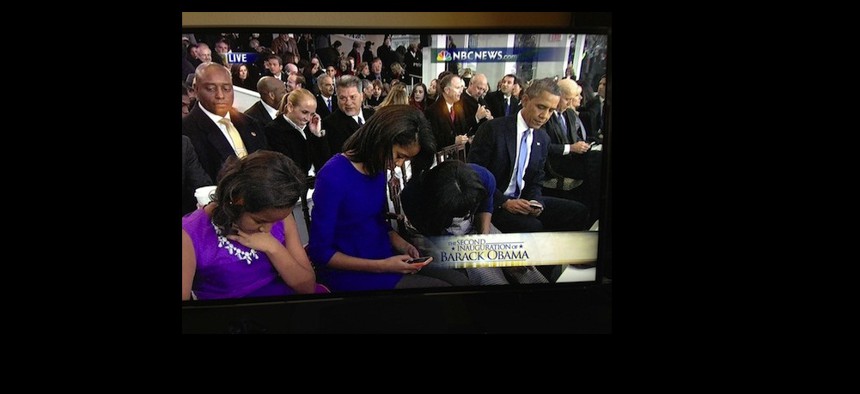
Distractions abound: In an image from the inauguration, the entire Obama family is seen using their smartphones. (Jared Keller/Twitter)
3 Ways to Cure Your Smartphone ADD
Three simple ways to remedy your Executive ADD and be a better leader.
Believe me, I don’t usually take pictures in restrooms but, in a “can’t believe what I’m seeing moment”, I had to snap the shot that accompanies this post. In case it’s not showing up as you’re reading this, it’s a sink faucet with a working video screen affixed to the top. I saw it today in the men’s room of a major conference center somewhere in America. Apparently, it’s come to this – faucets with screens for those who get bored while washing their hands:

As many others have observed, it’s hard not to conclude that the ever present screens in our life are changing the way we think. Without a doubt, they’re changing the way we interact. Last night, for example, I took my son to see Zero Dark Thirty (really thought provoking). We got there right before the previews started and sat in the back of the stadium style theatre. I’d guess about 70 percent of the heads in front of me were looking down at a smartphone screen. It’s not like most of the people in the theatre were there by themselves. There were plenty of couples where both of them were looking at their phone.
Of course, this phenomenon is not limited to movie theatres (or rest rooms for that matter). Most of us have smartphone induced attention deficit disorder and it shows up at work just like it does in most other arenas of life. It has to be affecting the quality of your team’s conversation and decision making. If you’re an executive, you, therefore, have a responsibility and an opportunity.
The responsibility is be fully present for the people you’re leading and not sneaking peaks at your phone. (OK, I’ll admit I’ve done this too.) The opportunity is to begin to change the culture of your organization by being the leader who’s a role model for being present. When you stop and think about the best leaders you’ve ever worked for, there are probably at least one or two that made you feel like the conversation they were having with you was the most important thing they were going to do that day.
Here, then, are three simple ways to start curing your Executive ADD and be that kind of leader:
Leave the Phone Behind: I currently have clients who have adopted this practice with great success. When they leave the office for a meeting, they leave their phone behind. After initial periods of withdrawal, they have all reported a significant increase in the productivity of their meetings as well as an increase in how satisfied they are with the meetings. In a couple of months, I’m going to be surveying their colleagues to ask them if it’s made any difference to them. My guess is the majority will say yes.
Create a Picture: Instead of taking the last couple of minutes before a conversation to answer a few more e-mails, put the phone down and take a deep breath. Ask yourself two questions. First, what am I trying to accomplish in this next meeting? Second, how do I need to show up to do that? Create a picture in your mind of what it all should look like. If you’ve got that picture in your head just before you start the meeting, you’re much more likely to stay focused and engaged.
Meditate: Try spending five minutes a day with your eyes closed while you focus on your breathing. Pay attention to each inhale and each exhale. If you’re new to this, you’ll probably find that you’re thinking about other things about thirty seconds after you start. That’s OK, everybody does that. Just come back to your breath as soon as you notice your mind wandering. With regular practice, you’ll probably get to sixty seconds without wandering and then a couple of minutes and maybe, eventually, five full minutes. How long you go really isn’t the point. The point is to build your muscles around focusing on one simple thing, noticing when you don’t and coming back to that thing sooner rather than later when you don’t.
What’s your take on Executive ADD? What are your pet peeves about it? What tips or techniques do you have for curing it?







